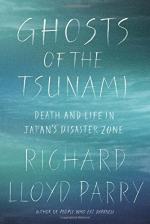|
This section contains 547 words (approx. 2 pages at 400 words per page) |

|
Ghosts of the Tsunami Summary & Study Guide Description
Ghosts of the Tsunami Summary & Study Guide includes comprehensive information and analysis to help you understand the book. This study guide contains the following sections:
This detailed literature summary also contains Topics for Discussion on Ghosts of the Tsunami by Richard Lloyd Parry.
The following version of this book was used to create this guide: Parry, Richard Lloyd. Ghosts of the Tsunami: Death and Life in Japan’s Disaster Zone. Farrar, Strauss, and Giroux, 2017.
Ghosts of the Tsunami, by Richard Lloyd Parry, is an account of the events before, during, and after the deadly tsunami of 2011 which struck the Tohoku coastal region of Japan. Parry's book is told from the first-person perspective and incorporates the author's and several interviewees' thoughts and recollections about the event in question. The book focuses heavily on a particularly tragic series of deaths at Okawa Primary School, where almost the entire student body was killed by the incoming tsunami. Parry's writing loosely follows the development of a court case in which angry Okawa parents sought justice and the truth about their dead children's last moments, claiming that teachers and staff neglected to properly evacuate the student body.
Parry's book is divided into five parts, each of which focuses on a topic related to the tsunami but ranging in the degree to which they relate to the Okawa Primary School tragedy itself.
Part I is called “The School Beneath the Wave” and contains all of the chapters from “Having Gone, I Will Come” to “Jigoku.” It primarily serves to introduce the reader to the Okawa Primary School tragedy, though it also introduces key witnesses such as Sayomi Shito, Hitomi Konno, Tetsuya Tadano, etc., all of whom are tied together by loss through the Okawa tragedy.
Part II is called “Area of Search” and contains the chapters from “Abundant Nature” to “What It’s All About.” This part focuses on the actual destruction of the tsunami and the ensuing search for dead bodies. Here, Parry explains the significance of the Tohoku region to Japanese culture and geography and also returns to the question of dead Okawa students. According to some of the individuals he interviewed, there is a great deal of mystery surrounding responsibility for the deaths of the students.
Part III is called “What Happened at Okawa” and contains the chapters from “The Last Hour of the Old World” to “The River of Three Crossings.” This part mostly discusses the Fukuji group’s search for the truth behind Junji Endo’s actions during the evacuation of the school, bringing out the author's journalistic background as he delves into investigative details.
Part IV, “The Invisible Monster,” contains the chapters from “In the Web” to “There May Be Gaps in Memory” and explains at length the phenomenon of the tsunami itself. It explores the feeling of being submerged, of being hurt by a wave and being unable to place blame on any single individual. The agony of the tsunami in part lies in its sheer natural inevitability and force.
The last part, “Gone Altogether Beyond,” contains only the chapters “Consolation of the Spirits” and “Save Don’t Fall to Sea.” It describes the aftermath of the Fukuji group’s court case and also delves somewhat into the question of spiritual healing after trauma.
Overall, the book introduces the Okawa tragedy and the proceeds to investigate it at length throughout the five parts, yet each part shifts the angle of questioning slightly and thus gives the reader a broad and thorough understanding of the 2011 tsunami in Japan.
Read more from the Study Guide
|
This section contains 547 words (approx. 2 pages at 400 words per page) |

|



